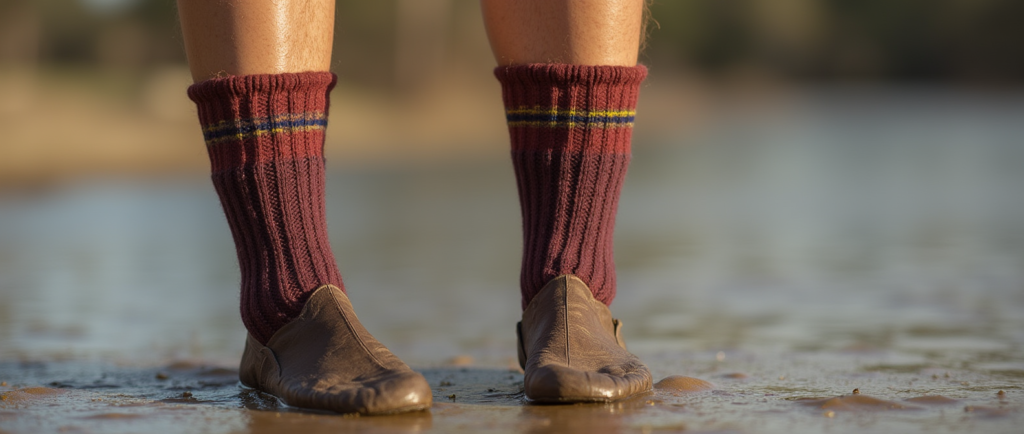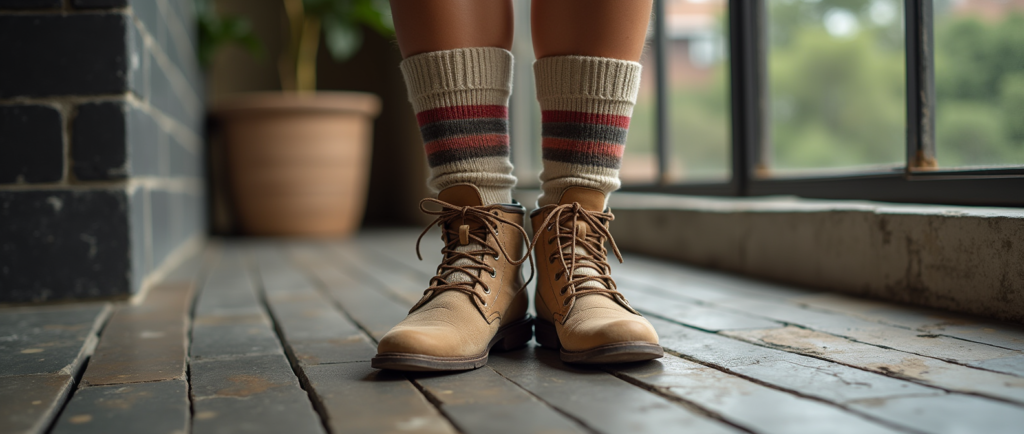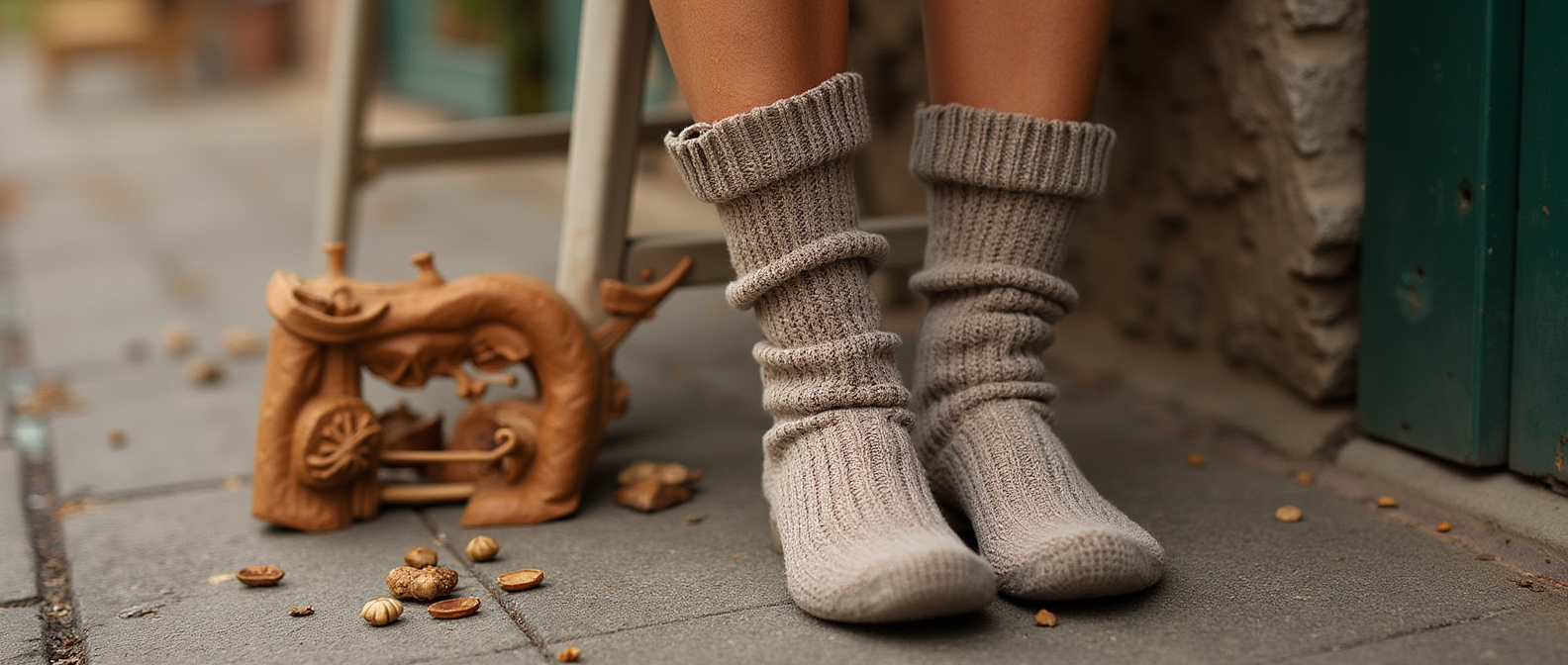Are you tired of blisters and cold feet during outdoor adventures? The right boot socks can change everything. Whether you’re hiking or snowshoeing, the right socks can boost your comfort and performance.
Boot socks offer a range of materials and technologies. Each is made for different activities and weather. Find the perfect mix of comfort, warmth, and durability for your boots.
Table of Contents
Understanding Boot Socks: Materials and Technology
Choosing the right boot socks means looking at the materials and tech used. Today’s socks come in many types, each with its own benefits. They help keep your feet comfy, durable, and perform well.
Natural vs. Synthetic Fiber Blends
Natural fibers like wool, cotton, and bamboo are popular for boot socks. They keep you warm, wick away moisture, and feel soft. Synthetic fibers, like polyester and nylon, are durable and manage moisture well.
Many socks now blend natural and synthetic fibers. For example, moisture-wicking socks might have a bit of Lycra for a snug fit. Cushioned socks might have synthetic padding for extra comfort.
Advanced Moisture Control Features
High-performance boot socks are great at controlling moisture. Insulated socks use tech to keep you dry, even when you’re active. Some have mesh panels for better air flow and to stop heat and moisture buildup.
Durability Factors in Modern Boot Socks
Durability is key when picking boot socks. Look for socks with reinforced heels and toes. Bamboo socks or nylon blends are also durable. Some socks have special zones for support and cushioning.
Knowing about the materials and tech in boot socks helps you choose. This way, your feet stay comfy, dry, and safe, no matter what you’re doing or the weather.


Essential Features of Quality Boot Socks
Choosing the right boot socks is key for comfort and performance. Look for features like cushioning and seamless toes. These can make a big difference, whether you’re walking in the snow or working all day.
Cushioned socks offer extra comfort. They protect your feet from each step and prevent blisters. Choose socks with extra cushioning in the heels and balls of your feet.
Arch support is also vital. Good socks fit snugly and support your feet well. This is crucial for standing or hiking for long periods.
- Seamless toe construction minimizes chafing and irritation, ensuring a smooth, comfortable fit.
- Moisture-wicking fabrics like merino wool or synthetic blends help keep your feet dry and prevent the buildup of sweat, which can lead to discomfort and odor.
- The height of your boot socks can also impact their performance. Crew socks provide additional coverage and protection, making them a popular choice for taller boots and winter socks.
By focusing on these key features, you can find the best boot socks. They’ll keep your feet comfortable all day, no matter what you’re doing or the weather.
Top-Rated Wool and Thermal Boot Socks for Winter
When it gets cold and snowy, the right winter boot socks are key. They keep your feet warm, dry, and comfy. Merino wool socks and insulated ones are top picks for their great temperature control.
Merino Wool Options for Extreme Weather
Merino wool socks are perfect for cold weather. They’re known for keeping you warm, drying fast, and controlling temperature. They’re great for skiing, snowshoeing, and ice fishing because they’re warm but not heavy.
Insulated Performance Varieties
Insulated socks offer top-notch protection from the cold. They use special materials to keep your feet warm and block out the cold. Plus, they help keep your feet dry and comfy.
Temperature Regulation Technology
- Special fabrics in wool socks help keep your feet at the right temperature. They adjust to your body’s needs.
- They also have vents and moisture-wicking zones. This stops you from getting too hot and sweaty.
- Some insulated socks even have heated parts. They give extra warmth where you need it most.
Whether you’re skiing or walking in the snow, the right thermal socks are crucial. They keep your feet warm, dry, and comfy all winter.

Choosing the Right Boot Socks for Different Activities
Choosing the right boot socks is not simple. The activity you do matters a lot. Whether hiking, working, or dressing up, the right socks make a big difference.
Hiking Socks: Prioritizing Durability and Moisture Control
Hiking socks are essential for outdoor lovers. They should be made of breathable, moisture-wicking materials like merino wool or synthetic blends. These keep your feet dry and comfy, even on long hikes. They also need to be durable for rough terrain.
Work Boots: Balancing Comfort and Support
For those on their feet all day, choose socks that are both comfy and supportive. Look for ones with extra cushioning in the heels and toes. They help prevent blisters and reduce foot fatigue. Socks that control moisture and are antimicrobial are also good for keeping your feet healthy.
Dress Boot Socks: Elevating Your Style
For a stylish look with dress boots, pick socks in soft colors and patterns. They should be thin and fit well with dress boots. Choose high-quality materials like cotton or merino wool for comfort.
Finding the right boot socks depends on your activity. Think about the material, cushioning, and moisture control. This way, you’ll find the perfect socks for your needs, keeping your feet happy and your performance top-notch.
Proper Care and Maintenance of Boot Socks
Keeping your premium boot socks in top shape is key. Whether they’re made of wool, bamboo, or have moisture-wicking tech, proper care is essential. Follow a few easy steps to make your thermal socks last longer.
Washing and Drying Guidelines
When washing your boot socks, stay away from harsh detergents and hot drying. Use a gentle, wool-safe detergent and wash in cold or lukewarm water. Don’t use fabric softeners, as they can harm the natural moisture-wicking of wool and bamboo. Air-drying is best to avoid shrinkage and damage from high heat.
Extending Sock Lifespan
To make your premium boot socks last longer, hand-wash or use a delicate cycle. This gentle method helps keep the fabric in good shape. Also, check your socks regularly for wear and tear. Fixing small issues early can prevent bigger problems and extend their life.
Storage Recommendations
Storing your boot socks right is important for their shape and condition. Don’t fold or crease them, as it can cause permanent damage. Store them in a cool, dry spot, like a drawer or closet, away from sunlight or heat. If you can, use a breathable container or hang them to keep them in shape.
By washing, drying, and storing your boot socks correctly, you’ll get more use out of them. This way, your investment in quality, comfy footwear will pay off for many seasons.
Conclusion
Investing in quality boot socks can greatly improve your comfort and performance. Whether for hiking or everyday wear, the right boot socks offer support and insulation. They also control moisture to keep your feet happy and healthy.
Choosing between Merino wool and synthetic thermal socks depends on your needs. It’s important to pick socks that fit your activities well. Understanding materials, moisture control, and durability helps you make the best choice.
Well-cared-for boot socks can last for years. Following washing, drying, and storage tips can help. This way, your socks will keep supporting and protecting your feet, no matter the activity.
FAQ
What are the different types of boot socks?
There are many types of boot-socks. You can find hiking socks, thermal socks, and wool socks. There are also crew socks, moisture-wicking socks, and cushioned socks. Insulated socks and winter socks are great for cold weather.
What materials are used to make high-quality boot socks?
High-quality boot-socks are made from natural and synthetic materials. Merino wool, bamboo, and moisture-wicking synthetic fabrics are common. These materials help with warmth, breathability, and durability.
What features should I look for in a good pair of boot-socks?
Look for boot-socks with good cushioning and arch support. Seamless toe construction is also important. Crew socks are a good height option. These features ensure comfort and prevent blisters.
What are the best boot-socks for extreme winter conditions?
For very cold weather, Merino wool socks and insulated thermal socks are best. They help keep your feet warm and dry in freezing temperatures.
How do I choose the right boot socks for different activities?
Choose boot-socks based on your activity. For hiking, go for cushioned socks that wick moisture. Work boots need durable socks. Dress boots are best with thinner, formal socks like wool or bamboo.
How do I care for and maintain my boot socks?
To keep your boot-socks in good shape, wash and dry them as instructed. Avoid fabric softeners. Store them in a cool, dry place. With the right care, your boot-socks will last a long time.
- Spectra Sock for Prosthetic Foot: Comfort, Durability, and Enhanced Mobility
- best Socks for Foot Neuropathy – Shop Comfort and Support
- Do Compression Socks Help Neuropathy? Find the Right Pair Now
- Best Compression Socks for Neuropathy – Relieve Pain Today
- Socks for Neuropathy: How They Help Relieve Foot Pain and Improve Comfort

